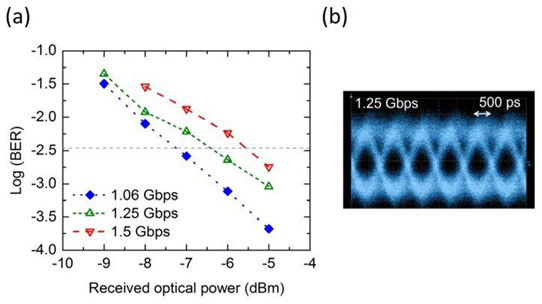- News
9 August 2017
Near-ultraviolet laser diodes powering visible (white) light communication
Researchers based in the USA and Saudi Arabia claim the first demonstration of the use of near-ultraviolet (NUV) laser diodes (LDs) and red-green-blue (RGB) phosphors for white visible light communication (VLC) [Changmin Lee et al, Optics Express, vol25, p17480, 2017]. The team is at University of California Santa Barbara (UCSB), King Abdullah University of Science and Technology (KAUST) in Saudi Arabia, and University of Wisconsin-Madison in the USA.
An advantage of using NUV would be reduced noise from solar radiation, compared with blue emitters. Laser diodes should have the ability be modulated at higher speed compared with light-emitting diodes (LEDs). This is because the limiting factor for laser diodes is photon lifetimes in the laser cavity, rather than electron/hole lifetimes, as for LEDs. The researchers also see potential for NUV LD-powered white-light illumination, based on high current and power density, compared with LEDs.
Potential uses of white-light VLC include light fidelity (LiFi) networks, underwater wireless optical communications (UWOC), and plastic optical fiber (POF) communications.
The 410nm laser diodes was a 4μmx1200μm ridge-waveguide device grown on semi-polar (20-21) free-standing gallium nitride. The facets were uncoated.

Figure 1: (a) Schematic of NUV laser-based white light communication system with RGB phosphors for color conversion, diffuser to improve uniformity of phosphor emission, transmitter (Tx) and receiver (Rx) lenses to collimate light, and 1GHz APD to collect transmitted light. (b) Photograph of setup.
The laser light was used to excite a mix of RGB phosphors in silicone (Figure 1) – respectively, CaAlSiN3:Eu2+, (Ba,Ca,Sr,Mg)2SiO4:Eu2+, and BaMgAl10O17:Eu2+. The components give quantum yields to 410nm wavelength light of 74%, 78% and 78%, respectively. The RGB Commission Internationale de l’Eclairage (CIE) chromaticity coordinates of the phosphors were (0.65, 0.36), (0.27, 0.64) and (0.14, 0.08), respectively.
The laser diode was mounted in a microwave probe station on a heat sink and thermoelectric cooler (TEC). The distance between the laser diode and phosphor was between 1cm and 2cm.
The laser diode continuous wave (CW) 15°C threshold current and voltage were 320mA (6.67kA/cm2) and 5.5V, respectively. The slope efficiency was 0.36W/A. The -3dB bandwidth for modulation was about 1GHz above 400mA biasing. The limited bandwidth was attributed to the avalanche photodetector (APD), since the laser diode was expected to have a bandwidth of the order 5GHz or more.
The team comments: “Higher modulation bandwidths are expected under the drive current of 400mA to 600mA for similar laser-based VLC systems with the eventual development of higher-bandwidth silicon APDs.”
The correlated color temperature (CCT) of the white light excited ranged from 4700K to 4050K as the injection current increased from 100mA to 600mA. The color rendering index (CRI) increased to 79 between 500mA and 600mA injection.
Previous work by some members of the team on white light generated using blue laser diodes and yellow YAG:Ce phosphor had only managed CRI values of 58. Higher CRIs (89) and lower CCT (3236K) have been obtained using blue laser diodes in combination with chemically unstable perovskite phosphor material containing lead, with associated toxicity and safety concerns limiting commercial potential.
Testing using non-return-to-zero (NRZ) on/off key (OOK) modulation with a 210 − 1 pseudo-random binary sequence (PRBS) data stream at 1.5 gigabits per second (Gbps) managed 3.8x10-3 forward error correction (FEC) and a bit-error rate (BER) of 1.8x10-3 (Figure 2). Clear open eye diagrams were demonstrated at 1.25Gbps and 570mA drive current. “Since the APD limits the system bandwidth to 1GHz, it is expected that the actual data rate is greater than 1.5Gbps,” the team comments.

Figure 2: (a) Dependence of BER on received optical power characteristics of laser-based white light communication link at different data rates with FEC criteria shown as grey dashed line. (b) Eye diagram.
The researchers also hope that using schemes such as quadrature amplitude modulated orthogonal frequency division multiplexing (QAM OFDM) in combination with higher-speed photodetectors will significantly increase data rates.
Near-ultraviolet laser diodes Laser diodes
https://www.osapublishing.org/oe/abstract.cfm?uri=oe-25-15-17480
The author Mike Cooke is a freelance technology journalist who has worked in the semiconductor and advanced technology sectors since 1997.


